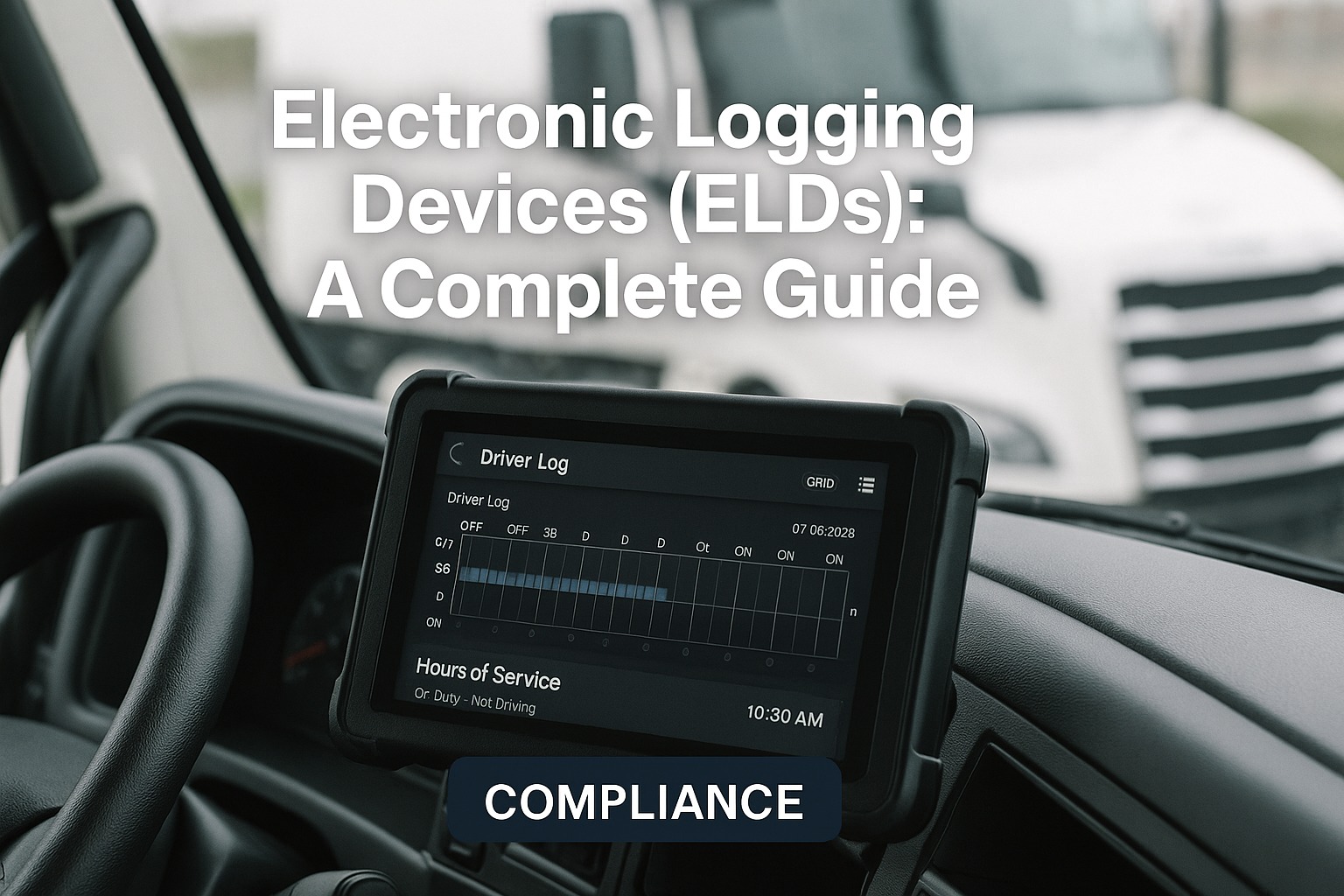ELD Impact on Fleet Operations: By the Numbers
The transformation from paper logs to electronic systems delivers measurable benefits beyond compliance:
93%
Reduction in HOS violations
$45K
Annual savings per truck
35%
Efficiency improvement
78%
Faster roadside inspections
Understanding ELDs: Technology, Compliance & Benefits
1. ELD Fundamentals & Technology
Essential KnowledgeCore Function: Automatically record driving time, engine hours, vehicle movement, and location data
Technology Stack: GPS tracking, engine diagnostics interface, cellular/satellite connectivity, secure data storage
Integration: Connects to vehicle ECM via J1939/J1708 protocols, syncs with fleet management systems
2. FMCSA ELD Mandate Requirements
Regulatory Must-KnowWho Must Comply: All commercial drivers required to maintain Records of Duty Status (RODS)
Key Dates: Full enforcement since April 1, 2018; grandfathered AOBRDs sunset December 16, 2019
Technical Standards: Must meet 49 CFR 395.15 specifications, self-certified by manufacturers
3. Hours of Service (HOS) Integration
Operational ExcellenceAutomated Tracking: 11-hour driving limit, 14-hour on-duty window, 30-minute break requirements
Smart Alerts: Proactive warnings before violations, automated duty status changes, exception management
Flexibility Features: Personal conveyance, yard moves, adverse conditions provisions
4. Advanced ELD Features & Analytics
Competitive EdgeBeyond Compliance: IFTA reporting, driver scorecards, fuel efficiency monitoring, predictive maintenance
Fleet Intelligence: Route optimization, idle time reduction, driver behavior coaching, detention tracking
Integration Ecosystem: TMS connectivity, dispatch systems, mobile apps, customer portals
5. Roadside Inspections & Data Transfer
Inspection ReadyTransfer Methods: Bluetooth, email, USB, web services per FMCSA specifications
Required Data: Driver logs, vehicle information, motor carrier details, ELD identifier
Best Practices: Pre-inspection data validation, driver training, mock inspections
6. ELD Selection & Implementation Strategy
Success FrameworkSelection Criteria: FMCSA registration status, hardware reliability, software features, support quality
Deployment Phases: Pilot testing, phased rollout, training programs, continuous optimization
Change Management: Driver buy-in strategies, incentive programs, feedback loops
Transform Your Fleet Compliance Today
Join industry leaders achieving 93% fewer violations and $45K annual savings with advanced ELD solutions.
2025 ELD Cost-Benefit Analysis
| ELD Solution Type | Initial Investment | Monthly Cost | Annual Savings | Payback Period |
|---|---|---|---|---|
| Basic Compliance ELD | $300/truck | $30/truck | $15,000/truck | 30 days |
| Advanced Fleet ELD | $600/truck | $50/truck | $35,000/truck | 45 days |
| Enterprise Platform | $1,200/truck | $75/truck | $45,000/truck | 60 days |
| Integrated Telematics | $1,800/truck | $100/truck | $65,000/truck | 75 days |
| AI-Powered Solution | $2,500/truck | $150/truck | $85,000/truck | 90 days |
| 100-Truck Fleet Average | $7,500/month | $4.5M annually | 60 days | |
ELD Implementation Roadmap
Week 1-2: Assessment
Foundation Building
- Audit current compliance status
- Analyze violation history
- Define success metrics
- Select ELD vendor
Week 3-4: Pilot Program
Controlled Testing
- Install on 5-10% of fleet
- Train pilot drivers
- Test all workflows
- Gather feedback
Week 5-6: Full Deployment
Fleet-Wide Launch
- Phased installation schedule
- Comprehensive training
- 24/7 support activation
- Compliance monitoring
Week 7-8: Optimization
Maximize Value
- Analyze compliance data
- Implement advanced features
- Refine processes
- Measure ROI
Common ELD Violations & Prevention
❌ Form & Manner Violations
Issue: Missing required data fields, incorrect status
Prevention: Automated validation, daily log reviews, driver training on proper entries
❌ Data Transfer Failures
Issue: Cannot transfer logs during inspection
Prevention: Test all transfer methods monthly, maintain backup options, driver practice sessions
❌ Unassigned Driving Time
Issue: Vehicle movement without driver login
Prevention: Daily unassigned time review, automated alerts, clear assignment procedures
❌ Missing Supporting Documents
Issue: No bills of lading, fuel receipts
Prevention: Document management system, mobile scanning apps, automated matching
❌ ELD Malfunctions
Issue: Device failures without backup
Prevention: Regular diagnostics, spare units, paper log training, 8-day repair window
❌ Inadequate Driver Training
Issue: Improper use leads to violations
Prevention: Certification programs, refresher training, video tutorials, mentorship
Industry-Specific ELD Applications
Long-Haul Trucking
- Team driver management
- Cross-border compliance
- Sleeper berth flexibility
- Split logging options
Benefit: 15% more revenue miles
Local Delivery
- Short-haul exceptions
- 150 air-mile radius
- Time card integration
- Multi-stop optimization
Savings: $25K per driver annually
Construction/Oil Field
- Yard move provisions
- Off-road tracking
- Waiting time logging
- Site-specific rules
ROI: 50% compliance improvement
Agricultural Transport
- Ag exemption management
- Seasonal variations
- Source documentation
- 150-mile exemption
Value: Simplified compliance
Master ELD Compliance & Unlock Fleet Potential
Don't let compliance challenges hold you back. Implement advanced ELD solutions and join fleets saving $45K annually per truck.
Frequently Asked Questions About ELDs
Several exemptions apply: vehicles manufactured before model year 2000 (no ECM), driveaway-towaway operations, vehicles operating under short-haul exceptions (150 air-mile radius), and drivers who operate under the 8-day/30-day exceptions. Additionally, agricultural operations have a 150-mile exemption from the source of agricultural commodities. Always verify current exemptions as regulations evolve.
ELD violations range from $1,000 to $11,000 per offense, with average fines around $2,750. Common violations include: no ELD when required ($1,474), form and manner errors ($238), and false logs ($13,227). Prevention strategies: daily log audits, automated compliance alerts, regular training, and maintaining backup paper logs. Fleets using advanced ELD systems report 93% fewer violations, saving $15,000-$45,000 annually per truck.
AOBRDs (Automatic On-Board Recording Devices) were grandfathered until December 16, 2019. Key differences: ELDs require engine synchronization, automatic recording of drive time, standardized data transfer methods, and stricter technical specifications. ELDs cannot be edited by drivers without annotation, provide better audit trails, and integrate with vehicle diagnostics. All commercial fleets must now use FMCSA-registered ELDs - AOBRD grace period has expired.
ELDs support team operations through: separate driver profiles with quick login/logout, automatic co-driver status changes, split sleeper berth provisions, and synchronized HOS calculations. Best practices include: establishing clear login procedures, using driver-specific key fobs or cards, regular co-driver status verification, and utilizing team-optimized ELD features. Teams using advanced ELDs increase utilization by 30% while maintaining compliance.
During malfunction: drivers must note the failure and inform carrier within 24 hours, continue operating but maintain paper logs, carrier has 8 days to repair/replace the ELD, and must maintain malfunction records for 6 months. Preparation tips: train all drivers on paper logging, keep blank paper logs in every truck, maintain spare ELD units, and document all malfunctions thoroughly. Proper malfunction procedures prevent violations and maintain compliance continuity.








